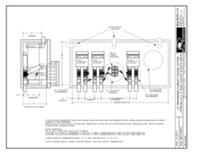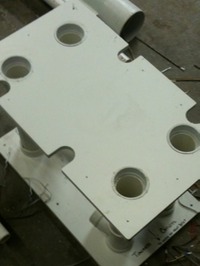Design Fexibility
Example Cuebox drawings
Standardized design
Cuebox drawdown depth is now standard at 10". For deeper drawdown, an extension table is now used.
For set less than 15", the Cuebox is trimmed.
The first thing customers asked for once alternating Flouts became available was a way to sequence two OR MORE Flouts. How could this be done without electricity or complicated controls? The answer is the CueBox™. It is named CueBox™ because it 1. Queues the Flouts to sink in order, 2. It’s shaped like a box, and 3. It uses a cueball, yes a cueball!
How it works:
Each Flout in a Cuebox system has an additional connection called a "trigger tube" . This connection allows liquid in from the Cuebox and sink the Flout before it normally would on it's own. The Cuebox is partitioned into square cells. There are usually two cells for each Flout served. There is a "lift cell" and a "trigger cell". In the appropriate cells are "lift floats" and "trigger floats". The tops of the floats are angled. A billiard ball rests on top of the floats. It rolls through holes in the cell walls as the floats move up and down when the chamber fills and drains. The trigger float with the ball in it is locked down and cannot float as high as the other trigger floats. The "trigger manifold" attached to the locked float allows liquid to flow through the trigger tube and sink the attached Flout. All other Flouts stay dry and keep floating. As the chamber drains, the ball moves from the trigger cell to the next lift cell. As the chamber fills, the ball moves to the next trigger cell. The ball cannot move further because the following lift float block the exit.
Recent improvements:
Trigger tube: Earlier Cuebox builds used flexible trigger tubing. The improved method uses rigid piping with smaller flexible connectors. The flexible tubing ran the risk of floating and airlocking. The rigid pipe is simpler and airlock proof. The small flex connectors are made of the same material as large Flout connectors. The durability of this material is well proven.
Standardization: Cuebox trigger manifolds must be set at the proper height. A standard drawdown height is now used and additional drawdown is provided by an extension table.
Switching: Flouts in a Cuebox system may now be "switched" on and off. By rotating the lift floats, the ball will detour around certain trigger cells. The associated Flout never sinks.
Siphon Replacement Job 1, Job 2
Cuebox™ US Patent Pending





